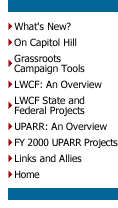 What happened to LWCF and UPARR
in the 106th Congress? Because of the work of an unprecedented
coalition of more than 5,000 organizations across the country,
including the nation's governors, mayors, major conservation groups,
state recreation and wildlife leaders, sportsmen's organizations,
historic preservationists, the sporting goods and outdoor recreation
industry, and the youth sports community, in May 2000, the House of
Representatives passed a comprehensive landmark conservation package
called the Conservation and Reinvestment Act (CARA).
What happened to LWCF and UPARR
in the 106th Congress? Because of the work of an unprecedented
coalition of more than 5,000 organizations across the country,
including the nation's governors, mayors, major conservation groups,
state recreation and wildlife leaders, sportsmen's organizations,
historic preservationists, the sporting goods and outdoor recreation
industry, and the youth sports community, in May 2000, the House of
Representatives passed a comprehensive landmark conservation package
called the Conservation and Reinvestment Act (CARA).
CARA fully funded LWCF at its authorized level of $900 million,
with $450 million distributed to federal lands and $450 million
distributed to states in matching grants, among other conservation
programs. The Senate Energy and Natural Resources Committee followed
suit by passing its own version of CARA. The bill's supporters
succeeded in getting sixty-six senators to sign a letter approving
passage of CARA in the full Senate.
It looked as if full funding for LWCF would become a reality. The
only enemy, given the election-year inclinations of Congress, seemed
to be the race to adjournment. But, then funny things began to
happen. Members of the powerful Senate and House Appropriations
Committees weighed in. Property rights advocates complained. Some
environmentalists did not like some of the bill. CARA stalled.
In the end, congressional appropriators cut a deal with the White
House that created a new land conservation provision included in the
FY 2001 Interior Appropriations Act. The provision -- called Title
VIII, the Land Conservation, Preservation, and Infrastructure
Improvement fund -- creates a $12 billion, six-year commitment to
conservation, mirroring CARA.
The package provides more than $1.4 billion in the first year,
then increases during the next six-years to $2.4 billion in annual
funding for a variety of conservation initiatives. Included are
LWCF's federal and state programs, funding for urban parks under the
Urban Park and Recreation Recovery Program (UPARR), conservation
easements, wildlife and endangered species protection, historic
preservation, and coastal protection programs. The legislation also
provides funding for maintenance of existing parks and
payment-in-lieu-of taxes (PILT) to communities to offset the loss of
revenue when open space is placed in community stewardship.
This commitment represents a major advancement in conservation
funding and provides more resources for more conservation programs
than has been seen in decades. Some in the environmental community
even have called it a "450 foot home run," given that the federal
LWCF program was allocated $450 million for FY 2001 and probably
will maintain that level of funding - if not exceeding it - in
future appropriations during Title VIII's six-year lifespan.
However, most concur that the initiative falls short on two
important grounds. First, the annual level of funding for all
programs, including LWCF, remains at the annual discretion of
Congress. Second, the funding for state and local conservation
efforts did not come even close to receiving the necessary dollars.
Although LWCF's state matching grants program received more than
double the previous year's allocation, it remains funded at less
than 20 percent of its authorized level. And, even though UPARR -
the state LWCF's urban sister program - was revitalized under Title
VIII, its funding level is not capable of matching the needs of an
ever-increasing urban population. Ironically, despite demonstrative
public support at the state and local levels for smart growth
initiatives and open space protection, Congress and Executive
agencies have shown a continued reluctance to make a genuine
conservation commitment "beyond the Beltway."









